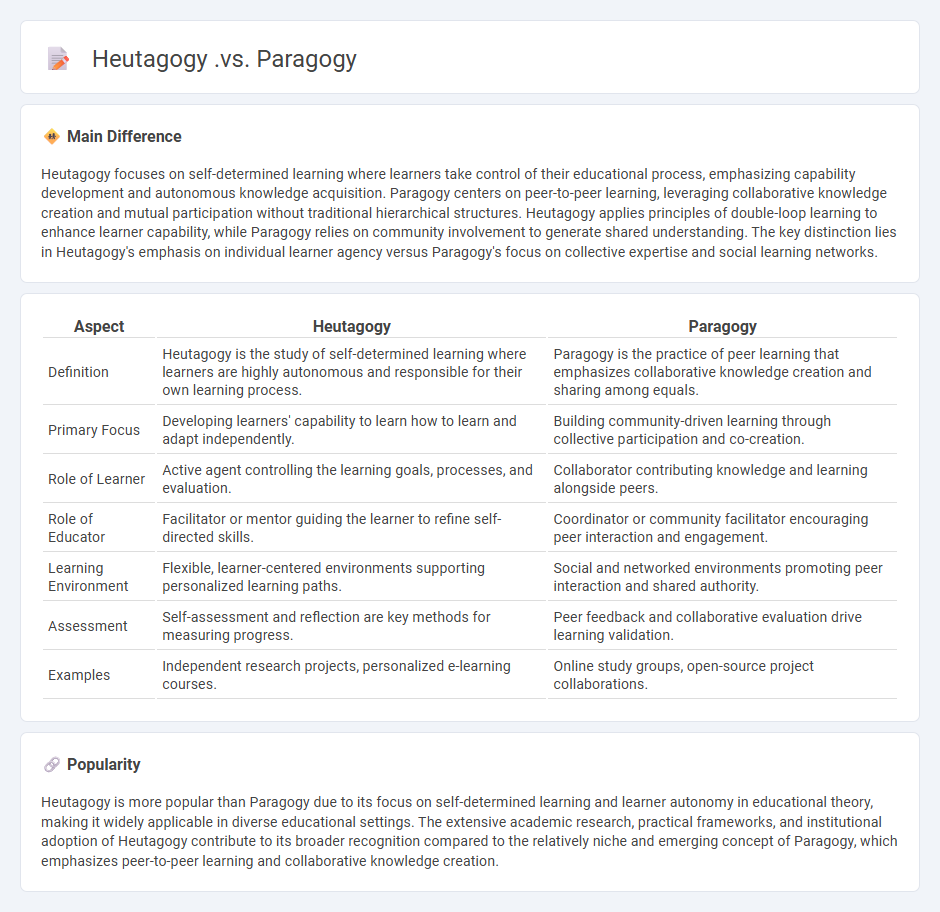
Heutagogy emphasizes self-determined learning where learners take control of their educational journey, focusing on capability and autonomy. Paragogy centers on peer learning, where knowledge is co-created within communities through collaboration and shared expertise. Explore the nuances of Heutagogy vs Paragogy to enhance educational strategies effectively.
Main Difference
Heutagogy focuses on self-determined learning where learners take control of their educational process, emphasizing capability development and autonomous knowledge acquisition. Paragogy centers on peer-to-peer learning, leveraging collaborative knowledge creation and mutual participation without traditional hierarchical structures. Heutagogy applies principles of double-loop learning to enhance learner capability, while Paragogy relies on community involvement to generate shared understanding. The key distinction lies in Heutagogy's emphasis on individual learner agency versus Paragogy's focus on collective expertise and social learning networks.
Connection
Heutagogy and Paragogy are connected through their shared emphasis on learner-centered approaches that promote autonomy and collaboration. Heutagogy focuses on self-determined learning where individuals take control of their educational journey, while Paragogy highlights peer-to-peer knowledge construction within communities. Both methodologies enhance lifelong learning by fostering critical thinking, adaptability, and co-creation of knowledge.
Comparison Table
| Aspect | Heutagogy | Paragogy |
|---|---|---|
| Definition | Heutagogy is the study of self-determined learning where learners are highly autonomous and responsible for their own learning process. | Paragogy is the practice of peer learning that emphasizes collaborative knowledge creation and sharing among equals. |
| Primary Focus | Developing learners' capability to learn how to learn and adapt independently. | Building community-driven learning through collective participation and co-creation. |
| Role of Learner | Active agent controlling the learning goals, processes, and evaluation. | Collaborator contributing knowledge and learning alongside peers. |
| Role of Educator | Facilitator or mentor guiding the learner to refine self-directed skills. | Coordinator or community facilitator encouraging peer interaction and engagement. |
| Learning Environment | Flexible, learner-centered environments supporting personalized learning paths. | Social and networked environments promoting peer interaction and shared authority. |
| Assessment | Self-assessment and reflection are key methods for measuring progress. | Peer feedback and collaborative evaluation drive learning validation. |
| Examples | Independent research projects, personalized e-learning courses. | Online study groups, open-source project collaborations. |
Self-directed learning
Self-directed learning in education emphasizes learner autonomy, promoting skills like critical thinking, time management, and self-assessment. Studies show that students who engage in self-directed learning achieve higher motivation and better academic outcomes. Digital platforms such as Khan Academy and Coursera support personalized learning paths, enabling learners to tailor content to their needs. Effective self-directed learning also requires access to resources, guidance, and a supportive environment to foster continuous growth.
Peer-based learning
Peer-based learning in education enhances student engagement and improves understanding through collaborative interactions. Studies show that peer tutoring increases academic performance by 10-15% across various subjects. Group discussions and peer feedback foster critical thinking and communication skills, essential for lifelong learning. Implementing structured peer learning programs in classrooms contributes to higher retention rates and positive social development.
Learner autonomy
Learner autonomy in education refers to students' capacity to take control of their own learning process, including setting goals, selecting resources, and self-assessing progress. Research shows that autonomous learners demonstrate higher motivation, improved critical thinking skills, and better academic performance across disciplines. Educational frameworks like the Council of Europe's Common European Framework of Reference for Languages emphasize fostering autonomy to enhance lifelong learning abilities. Effective implementation involves integrating metacognitive strategies, digital tools, and personalized feedback to support independent learning pathways.
Collaborative knowledge construction
Collaborative knowledge construction in education fosters active student engagement through group discussions and shared problem-solving activities, enhancing critical thinking and retention. Research shows that collaborative learning environments increase academic achievement by promoting diverse perspectives and deeper understanding of complex concepts. Technologies like collaborative online platforms and interactive tools further support real-time communication and knowledge sharing among learners. Educators emphasize structured collaboration to develop communication skills and foster a community of inquiry in classrooms.
Lifelong learning
Lifelong learning encompasses continuous, self-motivated pursuit of knowledge throughout an individual's life, beyond formal schooling. It integrates diverse educational formats, including online courses, workshops, professional training, and informal learning experiences. Research from the OECD highlights that countries promoting lifelong learning see higher employment rates and economic growth. Emphasizing digital literacy and critical thinking skills equips learners to adapt in rapidly evolving job markets.
Source and External Links
While there isn't a direct comparison between Heutagogy and Paragogy in the search results, here are three relevant resources related to Heutagogy and learning theories:Heutagogy - Self-Determined Learning in Education - Explains how Heutagogy encourages students to determine their own learning goals and processes.
Pedagogy, Andragogy, Heutagogy & Course Design - Discusses Heutagogy as a learner-centered approach where students are agents of their own learning.
Pedagogy vs. Heutagogy - Compares pedagogy, which is teacher-led, with Heutagogy, which is self-determined learning.
FAQs
What is heutagogy?
Heutagogy is a learner-centered educational approach focused on self-determined learning where individuals actively direct their own learning process.
What is paragogy?
Paragogy is a learner-driven educational approach emphasizing peer collaboration and self-directed knowledge construction.
How does heutagogy differ from paragogy?
Heutagogy focuses on self-determined learning where learners control the learning process, while paragogy emphasizes collaborative learning through peer interaction and co-creation of knowledge.
What are the principles of heutagogy?
Heutagogy principles include learner autonomy, self-determined learning, capability development, double-loop learning, non-linear learning paths, and emphasis on reflection and practical application.
What are the core ideas of paragogy?
Paragogy centers on learner-driven education, peer-to-peer collaboration, knowledge co-creation, self-directed learning, and the use of digital technologies to support open and participatory learning environments.
How do learners benefit from heutagogy?
Learners benefit from heutagogy by developing self-determination, critical thinking, and lifelong learning skills through self-directed, flexible, and learner-centered educational approaches.
Why should educators consider using paragogy?
Educators should consider using paragogy to promote learner-driven collaboration, enhance critical thinking, and foster lifelong learning skills through peer-to-peer knowledge exchange.
 calledges.com
calledges.com